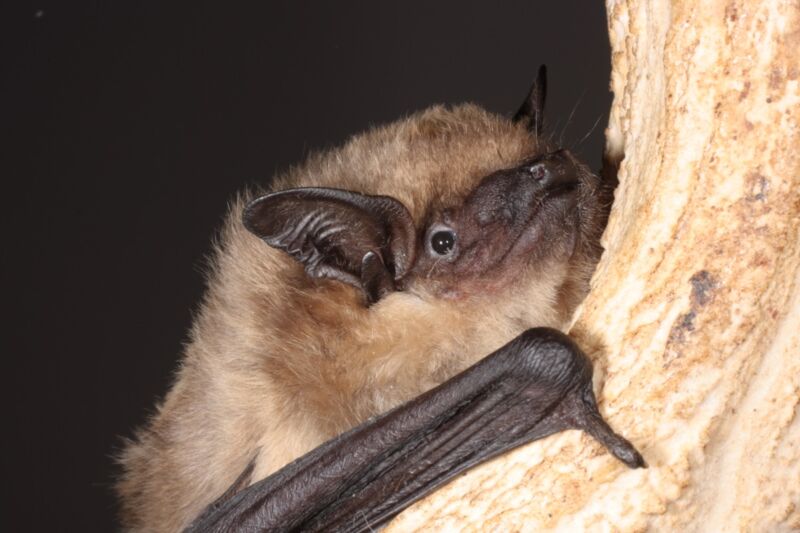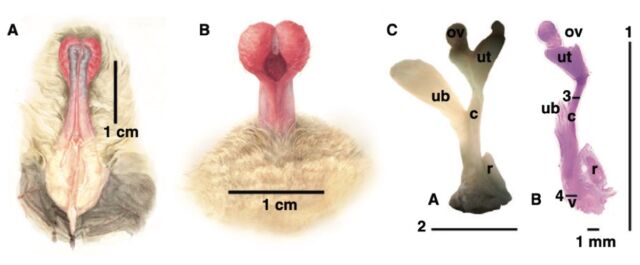
Little is known about the mating habits of the serotine bat (Eptesicus serotinus), but the males of the species boast unusually large penises—much larger than the vaginas of the females. The purpose of such an enormous organ has long baffled scientists. But a recent paper published in the journal Current Biology revealed that the males of this bat species use their gigantic members not for penetrating females while mating, but as an arm to push the female’s tail sheath aside, thereby improving the odds of successful insemination.
Eurasian serotine bats can be recognized by their long smoky-brown fur (with pale yellow-brown underbelly), large triangular ears, and distinctive flight pattern: bouts of flapping interspersed with brief glides. They typically roost in older buildings like churches that have high gables and cavity walls, or abandoned mines. The male bats are largely solitary until fall mating season arrives, when they seek out females. Females set up maternity colonies around late May in Europe and remain there throughout the breeding season, usually giving birth to a single offspring (pup) in late summer.
Female bats have unusually long cervixes, the better to store sperm. The males have penises that are seven times longer than the females’ vaginas, with a heart-shaped head seven times wider than the vaginal opening. “By chance, we had observed that these bats have disproportionately long penises, and we were always wondering, ‘How does that work?’” said co-author Nicolas Fasel of the University of Lausanne. “We thought maybe it’s like in the dog where the penis engorges after penetration so that they are locked together, or alternatively maybe they just couldn’t put it inside, but that type of copulation hasn’t been reported in mammals until now.”
To find out, Fasel et al. perused close to 100 videos depicting serotine bats in flagrante. Four of those videos came from a bat rehab center in Ukraine, but the rest were filmed mating in the attic of a Dutch church by an intrepid citizen scientist. The bats usually mated for less than 53 minutes on average, although one stud persisted for an impressive 12.7 hours. The earliest mating events occurred in September and peaked in frequency in October, although there were four mating events that occurred in March/April. The authors view this as evidence that both males and females can internally store sperm for months.

The act itself typically begins with a male bat latching onto a female, biting the skin on her nape, and then launching into a combination of hindquarter movement and “rapid probing movements of the fully erect penis.” Females often emitted social calls during this early mating stage, but the calls ceased once the male bat succeeded in pushing its penis right against the vulva, only moving intermittently after that. At no point did the male bats insert the penis into the vagina (intromission), and even if they’d tried, the fully erect penis head was so large that it wouldn’t have fit through the opening anyway.
The authors did observe that after mating, the female abdomen had a wet appearance, suggesting the presence of semen (i.e., the males ejaculated onto the females’ abdomens). This has previously been observed in little brown bats and noctule bats, but since Fasel et al. did not take a vaginal swab to test for the presence of sperm, this observation is inconclusive.
So why might the serotine bat have evolved such an enormous sex organ? The authors suggest that females might use their tail membranes to avoid mating, and the males’ long, thick penises could be used to push that membrane aside. “The hollow structure observed in the dorsal side of the erect penis might serve as a suction cup and support the maintenance of the copulatory contact,” the authors wrote. “Therefore, the penis’s size, shape, and prolonged embrace might further support the transport of sperm cells into the vagina and through the long cervix.”
The next step is to conduct further studies on the usual penis morphology and to capture the mating behavior of serotine bats in more natural contexts, comparing it with the mating behavior of other bat species. “We are trying to develop a ‘bat porn box,’ which will be like an aquarium with cameras everywhere,” said Fasel.
DOI: Current Biology, 2023. 10.1016/j.cub.2023.09.054 (About DOIs).
https://arstechnica.com/?p=1985239

